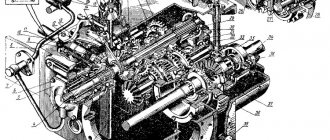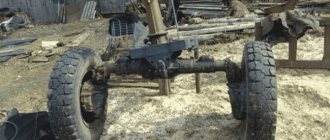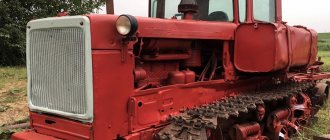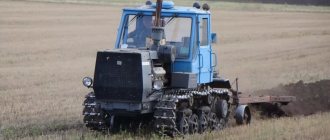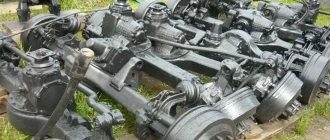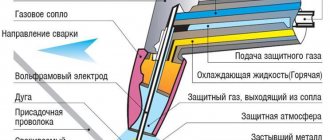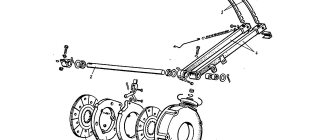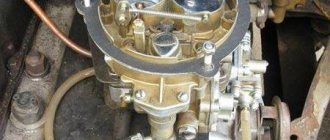Beet harvester is a technological complex for mechanized harvesting and processing of sugar beets (digging, trimming, unloading roots into piles or into transport). According to the method of carrying out the process, they are divided into two types: pulling and with preliminary cutting. Depending on the method of assembly, a beet harvester can be trailed or self-propelled. Main technological units: topper, cutter, digger, conveyors and lifts. Self-propelled machines are equipped with bunkers for temporary storage of roots (up to 30 tons). Some models of combines are equipped with conveyors for unloading tops. The drive of the actuators is electro-hydraulic. The working width varies from 1 to 12 rows. Operating speed up to 10 km/h. But in addition to this, stationary installations such as the OVS-25 heap cleaner may also be required.
Description
Designed for harvesting sugar beets.
- Harvester operating method:
- beet digging is carried out frontally from the soil;
- the topper crushes the beet tops;
- optional wide spread of tops for plowing, or loading directly onto adjacent trailers (supplied as additional equipment); the width of the tops spread is infinitely adjustable from the driver's cab;
- 6 adjustable topper cutters ensure optimal quality of tops sections;
- digging coulters remove beets from the soil;
- in extreme soil conditions or in heavily clogged plantings, a 2-stage connection of a vibrating coulter is possible;
- Beet cleaning is carried out carefully, but at the same time and efficiently through 8 spiral rollers, 1 separating elevator and 3 separating stars;
- Constantly optimal weight distribution on both axles, regardless of whether the hopper is full or empty;
- wide Terra tires guarantee gentle soil protection;
- the beets are transported through the ring elevator into the bunker and then evenly distributed using the bunker auger;
- The hopper is emptied through the unloading belt;
- the unloading process is accelerated due to the presence of a longitudinal and transverse scraper bottom;
- The combine guarantees:
- respect for the soil;
- good preconditions for subsequent soil cultivation at minimal cost;
- excellent performance on slopes when connecting an axle support;
Engine: automatic selection of shaft rotation speed when uprooting and moving along the highway.
- Chassis drive:
- Mechanical axles front and rear;
- The axles are driven by cardan shafts;
- Between both axles there is a two-speed hydraulically driven distributor box;
- Automatic control of engine rotation speed and motion drive;
The Terra Dos T-3 Plus model is equipped with dual wheels with a low pressure of 2.0 bar.
Axles: front portal planetary axle with steered wheels and brakes, heavy duty; At the rear there is a planetary axle with steered wheels and brakes, in a heavy design.
Locking devices: front and rear axle with switchable transverse differential lock. The gearbox is continuously variable. Tempomat at 1st and 2nd speeds.
Rotary topper cutter with adjustable tops ejection to the side (BS, VBS); optionally - integral rotary with inter-row tops placement (IBS, VIBS) on Terra Dos T-2.
- Topper cutter units for Terra Dos T-3:
- KOS-topper cutter (combined topper cutter);
- BS-topper (screw topper);
- IBS-bots cutter (integral tops cutter) specially manufactured for various countries;
- topper cutter without crushing the tops leaf (precision topper cutter);
- topper with cleaning shaft;
- topper for rows with hilling;
The topper is equipped with automatic cutting height adjustment; The top cutting height of all six knives is centrally adjustable from the driver's cab; The height of the topper tire for all 6 knives for cutting tops is adjusted from the driver’s cab.
Tops spreader: spreading range can be changed from the driver's cab; tilts and folds hydraulically for road traffic or haulm collection mode.
Collection of tops: carried out by means of a conveyor belt mounted using a quick-release device; The belt trailer included in the scope of delivery is intended for road transport of tops.
Rooter: switchable and switchable digging disc coulters with traction; linear lateral maneuverability to each other is 70 mm, with free resolution in an oil bath; maintenance-free with automatic depth guidance, carried out thanks to 7 copying (contact) wheels with drive; regulation is carried out from the driver's cabin; phase-shifted vibrating coulters; The lifter shafts are reversible.
- Row distance for Terra Dos T-2:
- PV 6 optional fixed 45, 48, 50, 55, 60 cm;
- VPV 6 variable 45-50, 45-48 cm;
- Row distance for Terra Dos T-3:
- PV 6-rooter - inter-row distance is fixed at 45 or 50 cm;
- VR-rooter with the ability to rearrange the height of the roller group and selectable row spacing - variable from 45 to 50 cm;
- KR-rooter with the ability to adjust the height of the roller group - fixed 45 or 50 cm;
The uprooting unit moves 200 mm to the left or right in the direction of travel, for a more careful handling of the subsequent row.
- Cleaning:
- 6 long spiral rolls;
- 2 short spiral rolls (4 on Terra Dos T-3);
- 1 separating elevator (reversible);
- 3 separating stars with automatic speed adjustment;
Screens: partially segmented screens or screens with spring teeth, infinitely variable and central screen height adjustment from the driver's cab with electronic display on the screen. Rearrangement of speed automatically and manually.
Elevator: two cam fabric belts with steel claws with two speeds. Terra Dos T-3 has two-layer belts with steel grips 900 mm wide with 5 speeds.
Distribution of beets in the bunker: auger with right and left thread, switchable automatically and manually.
The hopper bottom consists of a longitudinal and transverse bottom scraper, each with 4 high-strength, high-quality drive chains; automatic hydraulic chain tensioning, screw caisson bottom.
Emptying is possible only according to a scheme with a forced sequence of actions: unloading belt - transverse bottom scraper - longitudinal bottom scraper, adjustable in speed.
Unloading belt: width 1.85m, hydraulic folding instructions; during uprooting, the speed is adjustable; It is possible to load onto a nearby trailer during uprooting.
Driver's cabin: sound insulation 65 dB (A), seat next to the driver, 2 pivoting windows, heating, on-board computer, radio, optional air conditioning.
Beet harvester Kleine SF-10
The Franz Kleine beet harvester is a self-propelled unit that has the ability to reload beets into a vehicle moving nearby, as well as receive beets into an intermediate bunker; the latter allows the combine to cover large areas without stopping. Due to the large productivity over the area, the low level of cleaning costs, but at the same time its high quality, the “baby” from Klein convincingly demonstrates how high its efficiency is.
Photo of beet harvester Kleine SF-10
Technical features of the Klein combine
The beet harvester and digger are designed as two separate units. The topping machine is equipped with hydraulically controlled support wheels. The integral and serial topper is equipped with a topper chopping shaft, topper, topper and top trimmer mounted on a ski chassis. Adjustment of the cutting height and frequency, depending on the distance between the root crops in the row and the level of the root crop on the surface of the ground, can be set by the driver directly from the cab of the car. Thanks to the pressure accumulator, the topper is unloaded. Thus, the front support wheels only probe the soil and do not go into the ground, for example in rainy weather and damp soil.
Photo of beet harvester Kleine SF-10-2
In operation, the Franz Kleine SF 10 beet harvester impresses with its high maneuverability, as well as the high quality of the chassis and steering. The SF 10 owes its maneuverability primarily to its short wheelbase and large steering angle.
The hydrostatic drive of the chassis with a three-stage gearbox allows for infinitely variable speed control at each gearbox stage. In addition to steering the rear axle wheels when driving on the road, three control programs can be activated during digging via the graphical service terminal: all-wheel steering, dog-wheel steering, manual control via potentiometer.
Technical characteristics of Franz Kleine SF 10-2
| Length | 10.40 m |
| Width | 3.35 m |
| Height | 4.00 m |
| Weight | 16.850 kg |
| Engine Series | TWD 1240 VE, 6 cylinders, displacement 12 liters, turbocharger, charge air cooler, European standard EURO 2, power 275 kW (374 hp). |
| Engine Option | TAD 1251 VE, 6 cylinders, displacement 12 liters, turbocharger, European standard EURO 3A, power 286 kW (390 hp). |
| Engine speed | 1.400 – 1.700 rpm. |
| Diesel tank capacity | 610 l. |
| Front axle | U-shaped axle (trailer control with swivel bogie). |
| Rear axle | Fixed axle, suspended in a swinging position with hydraulic drive, steering with rotary knuckles. |
| Front tires | 710/70 R 38 |
| Rear tires | 750/45-30,5 |
| Distance between axles of wheelsets | 3.80 m |
| Motion drive | hydrostatic, with 3 gearbox speeds, the speed of movement is steplessly switched, forward, reverse |
| 1. speed 0 - 6 km/h | |
| 2. speed 0 - 12 km/h | |
| 3. speed 0 - 20 km/h | |
| Drive mechanism | stepless pressure-dependent |
| Management methods | possibility of selecting a control module on the front and rear axle (programming steering with all swivel wheels). |
| Row spacing | 45 cm standard. Other distances are offered as additional options. |
| Hopper capacity | 15 m3. Optional - 17 m3 |
| Unloading height | from 2.00 m to 4.20 m. Infinitely variable height adjustment. |
| Unloading width | 1.40 m |
| Automatic control | Copying probes (the signal is transmitted through the topper cutter to the rear axle). Control probe (through the digger to the front axle). |
| Digger | 45 cm standard. Integral top cutter. |
| Automatic depth | electrohydraulic control. |
| Hydraulic drive | Chopper shaft, tops auger, tops thrower, digger, transport rollers, roller group (reverse available), separating wheels (each wheel can be adjusted separately), elevator, bunker auger, unloading conveyor, sensitive element (proportional), automatic switch, (start of field , end of the rut). |
Important How to make a mobile or stationary sawmill from a chainsaw with your own hands
KOS I
integral topper with placement of chopped tops between rows
- Possibility of uprooting trail after trail
- The best starting situation for conservation tillage and sowing
Important What kind of oil to pour into a walk-behind tractor: is it possible to use automotive oil for a gearbox or an air-cooled engine?
This is interesting: Technical characteristics of the GAZ-4509 agricultural dump truck: a thorough look at the issue
Beet harvesters
The main means of harvesting beet plantations are combines. Despite the possibility of using separate trailed beet harvesting units for tractors, a significant part of the machines is a one-piece structure. The operating efficiency of such a unit reaches 96-98% of the total share of beets grown.
Most combine harvesters are equipped with a self-propelled chassis, on the chassis of which working units are hung or attached. Root crops are collected into bins of various sizes, from where they can be quickly loaded into transport equipment.
General information about beet harvesting equipment
A beet harvester is an agricultural unit of equipment for collecting sugar and fodder beets. Subsequently, the collected products are sent to processing plants. The combine is equipped with overhead equipment and a primary processing system.
Types of cars
There are several types of combines that differ from each other in their set of characteristics.
- Trailed. As a rule, these types of combines are used for harvesting beets in small areas, as they have a rather primitive design. Due to its low cost compared to its competitors, the trailed combine has low productivity.
- Self-propelled. Its main feature is that there is no need for large staff. Despite this, the combine is able to show a high level of productivity without auxiliary equipment. The technical component assures that with a combine of this type it is possible to obtain maximum efficiency with a minimum level of losses.
Among other things, combines are divided according to the method of collecting beet products.
- Teresity. With this method, the roots are removed from the ground along with the tops. Subsequently, the tops are trimmed in the combine itself.
- With preliminary cutting of the tops. With this method, the blades initially cut off the tops to the very roots, then special scoops collect the root crops themselves.
Table - Characteristics of beet harvesters:
| — | Price | Modernity | Amount of area to be processed |
| Trailed | Cheaper than competitors | Quite modern | Small areas |
| Self-propelled | Expensive | Modern | Large areas |
| Terebilny | Cheaper than competitors | Almost not used in modern agriculture | No difference |
| With preliminary cutting of the tops | Expensive | Modern | No difference |
Which type should I choose?
The outcome of this choice mainly depends on the size of the field in which beets are planted.
If it is a several-hectare area, the cleaning of which requires a lot of time and manpower, then you should choose a self-propelled harvester with preliminary cutting of the tops. However, it is expensive and not every farmer is able to purchase it. If the farmer is ready to spend more time on harvesting, then you can choose a beet harvester with a lifting method for harvesting beets. If a farmer owns a small field that does not require serious equipment, then a self-propelled combine can be easily replaced with a trailed one.
Principle of operation
Two main methods of operation of the beet harvesting unit have been developed. The tried and tested principle of operation is to extract root crops from the ground by holding them by the tops, which are cut off after the tuber is captured inside the machine.
Modern combine harvesters often use a different operating principle, in which beets are dug out of the ground without tops and subjected to additional processing (cleaning). Extraction is carried out through the operation of a complex of passive or active diggers located in several rows. This increases the operating speed of the movement and the cleaning efficiency in one pass.
The cut tops, depending on their further use, are disposed of in two ways. To obtain natural fertilizer, the tops are crushed and scattered against the direction of travel. Feed use of plant waste involves storage and unloading processes, accompanied by cutting.
Design and operating principle
A beet harvester is a mechanized complex for processing and harvesting beet plantings.
There are 2 types of harvesting machines:
- Teresity. Tops are trimmed inside the equipment after digging out the roots from the ground. The example is the first Soviet trailed 3-row topping combine KST-3A, manufactured at the Dnepropetrovsk Combine Harvester Plant in the 1970s. and used in the main beet growing zones and on non-irrigated land plots.
- With preliminary cut. First the tops are cut, then the roots. A representative of this type is the Soviet trailed 2-row complex SKD-2, produced in 1972, which harvests root crops in irrigated beet growing areas.
Important Distinctive features and characteristics of the KamAZ-54115 truck tractor
The main technological components of the combine using the KST-3 module as an example are as follows:
- Automatic hydro-following mechanism. Corrects the in-line direction of movement.
- Digging paws. The root system is pulled out of the soil, the earth ball is shaken out and the beets are fed from the gripping zone to the lifting apparatus.
- Top lifters. Gather vegetation into a bunch for freer paw grip.
- Pulling mechanism. Removes fruits from the ground and delivers them to the leveler. It is mounted on a movable frame and consists of 3 sections. To adjust the lifting height, gauge wheels are installed on the front of the frame.
- Leveler. Straightens the roots before mowing using the method of pulling up or settling to the height of the heads, then transfers them to the knives.
- Cutting elements. The vegetation is separated, one part is thrown with beaters onto a conveyor belt, the other onto a screw cleaner.
- Cleaner. The roots are separated from the earthen clod and plant debris, shaken out and cleaned.
- Loading elevator. The peeled beets are picked up and delivered to moving vehicles.
- Conveyor. Contains a paddle thrower that throws greens into a tractor trailer cart.
Design features
Regardless of the manufacturer and operating scheme of beet harvesting units, their design uses a common number of components and layout principles. A significant part of modern machines have two working units responsible for the assembly and processing of root crops. The first block is involved in digging up the beets, and their cleaning is carried out in the second block of the topping machine.
Tops are trimmed using devices of an active or passive cutting system. Active knives use an external power source and are usually represented by a rotating shaft with L-shaped knives.
The passive knife circuit works when the tuber is further fed into a storage container or transport. Units for additional pruning and cleaning of root crops contribute to increasing the cleanliness of work. Diagram of a beet harvester using the example of a self-propelled model E-684
1 — support-copying boxes; 2 — disk side shares; 3 - flat main shares; 4, 6 - first and second separator conveyors; 5 — soil grinder cylinders; 7 — guide fingers; 8 — topping roller; 9 — remote finger slide; 10 — potato drainage roller; 11 — unloading elevator.
Features of Ropa technology
German agricultural machinery manufacturers Ropa annually present new design solutions. The Ropa beet harvester is economical in terms of fuel consumption when actively collecting root crops. The functionality of these machines even includes a special economical operating mode. Reducing fuel consumption, in turn, allows the agricultural producer to reduce production costs. To work on large acreage and difficult conditions, the Ropa combine can be equipped with additional units of impressive dimensions. To increase the efficiency of harvesting, the agricultural machines of this German manufacturer are equipped with uprooters with the ability to operate in rows of different widths and the function of controlled cutting of tops. Additionally, a special trolley has been developed for Ropa combines for transporting wide-cut attachments on roads. This device is easy to control on turns and descents. The trolley is equipped with a braking system.
Review of popular manufacturers
Domestic models of combine harvesters are represented mainly by outdated models, which are used in a number of small agricultural farms. The highest reliability and performance are found in foreign models that have different performance and price characteristics.
"Holmer"
The models of this beet harvesting equipment are distinguished by highly automated control and continue to be improved, not stopping at several successful designs. The latest samples have a three-axis design, which allows the use of more productive and heavier machines. An additional wheel pair ensures the installation of a spacious bunker.
High engine power (up to 600 hp) is combined with high efficiency and an effective hydraulic drive system. Automated control minimizes the participation of the operator, who only needs to control the cleaning process.
Technical characteristics of Holmer “Terra Dos” beet harvesters:
Control
A control device that allows automatic turning of self-propelled combines will be awarded for the first time at Agritechnica 2017 with a Silver medal by the DLG Gremium. With the help of HOLMER SmartTurn, for the first time on self-propelled combines, the ability to automatically turn the combine on the outskirts (at the boundary) of the field has been realized. The process includes automatic lifting, automatic turning maneuver and automatic re-immersion of the lifting unit. The integrated software solution from REICHHARDT and HOLMER combines the mechanical steering system, boundary control and GNSS control (Global Navigation Satellite System) into one digital field for the first time. SmartTurn is kind to the soil, reduces crop losses, increases harvesting speed and relieves driver fatigue.
Important Which backhoe loader is better to choose from Europe (comparison)
A tricky way to turn around
The system, already known and tested on tractor technology, is being implemented for the first time on combine harvesters via HOLMER SmartTurn; it combines the mechanical steering system, boundary control and GNSS control into one digital field.
1. The system at the edge of the field, at the end of the row, automatically gives an acoustic signal for the optimal turning time, the driver-mechanic activates the turning, Terra Dos T4 automatically stops the digging process and raises the lifter at the ideal point in time.
2. At the same time, GNSS takes over control of the machine and begins the turning process using the optimal track.
3. After completing the turn, SmartTurn automatically lowers the lifter back into the soil at the ideal time point. Then the autopilot automatically takes over the work and digging continues. In addition, REICHHARDT SMART CONTROL records headland information and visualizes it, making it possible for the system to recognize it. The stored data is available for documentation and subsequent evaluation.
Advantages
SmartTurn takes care of
How does it work
There are 2 ways to operate the combine:
- thorny;
- with a preliminary cut.
The old method (pulling) involves extracting vegetables from the soil by holding them by the tops, which are cut off after removing the root crop inside the combine. The modern method (with a preliminary cut) is that the root crop is dug out of the soil without tops (they are cut off immediately) and cleaned. Extraction from the soil occurs through the work of diggers, which have several rows. This increases the speed of the combine and the efficiency of harvesting in one pass.
Tops can be disposed of in two ways. To obtain natural fertilizers, the tops are crushed and scattered against the direction of the machine. If the stems are to be used as animal feed, they are cut, unloaded and stored in boxes.
General information about beet harvesting equipment
Types of cars
There are several types of combines that differ from each other in their set of characteristics.
- Trailed. As a rule, these types of combines are used for harvesting beets in small areas, as they have a rather primitive design. Due to its low cost compared to its competitors, the trailed combine has low productivity.
- Self-propelled. Its main feature is that there is no need for large staff. Despite this, the combine is able to show a high level of productivity without auxiliary equipment. The technical component assures that with a combine of this type it is possible to obtain maximum efficiency with a minimum level of losses.
Among other things, combines are divided according to the method of collecting beet products.
- Teresity. With this method, the roots are removed from the ground along with the tops. Subsequently, the tops are trimmed in the combine itself.
- With preliminary cutting of the tops. With this method, the blades initially cut off the tops to the very roots, then special scoops collect the root crops themselves.
Table - Characteristics of beet harvesters:
| — | Price | Modernity | Amount of area to be processed |
| Trailed | Cheaper than competitors | Quite modern | Small areas |
| Self-propelled | Expensive | Modern | Large areas |
| Terebilny | Cheaper than competitors | Almost not used in modern agriculture | No difference |
| With preliminary cutting of the tops | Expensive | Modern | No difference |
Which type should I choose?
The outcome of this choice mainly depends on the size of the field in which beets are planted. If it is a several-hectare area, the cleaning of which requires a lot of time and manpower, then you should choose a self-propelled harvester with preliminary cutting of the tops. However, it is expensive and not every farmer is able to purchase it.
If the farmer is ready to spend more time on harvesting, then you can choose a beet harvester with a lifting method for harvesting beets. If a farmer owns a small field that does not require serious equipment, then a self-propelled combine can be easily replaced with a trailed one.
Models and their parameters
Several combine harvester models are currently produced, the technical characteristics of which allow the following tasks to be performed:
- beet digger extracts vegetables from the soil,
- then the tops are cut,
- after this, the tops are unloaded onto a nearby trailer or scattered across the field,
- then the beets are cleaned through 8 spiral shafts, a separating elevator and 3 separating stars.
The weight of the combine is evenly distributed on both axles. Wide tires do not damage the soil. The beets are transported through the elevator into the bunker and then distributed using an auger. The hopper is emptied via a discharge belt. Unloading is accelerated due to the presence of a transverse and longitudinal scraper bottom.
The beet harvester has the following advantages:
- small turning radius;
- does not damage the soil;
- can move along an inclined plane if the axle supports are connected.
Let's look at the features of Holmer Terra Dos T2. The unit is equipped with a 338 kW engine. The combine has an automatic selection of the engine shaft rotation speed when moving forward or uprooting.
Holmer Terra Dos T2 has a two-speed distribution box with a hydraulic drive; the engine rotation speed and the machine drive are automatically controlled. Portal axles with steered wheels and brakes are installed at the front and rear. The front and rear axles are equipped with a transverse differential lock.
The first speed is from 0 to 12 km/h, the second is from 0 to 25 km/h. Rotary tops cutter with adjustable tops ejection to the side or placement between rows. The topper is equipped with automatic adjustment of the processing depth. The tops spreader can change its spreading range from the operator's cab.
The tops are collected on a conveyor belt, which is installed using a quick-release device. The uprooter has digging coulters with traction, which can be turned on and off. Spiral rollers and an elevator are designed for cleaning root crops. The driver's cabin is equipped with rotating windows, heating, an on-board computer, a seat next to the driver, and good sound insulation.
The beet flow is controlled by an on-board computer. The distribution of oil in the hydraulics is controlled by a buzzer. There is automatic steering and a central lubrication system.
- Gas tank capacity - 1150 l.
- Bunker volume - 24 m³.
- Loading height - 3.8 m.
- Maximum length - 12 m.
- Maximum width - 3.3 m.
- Maximum height - 3.98 m.
- The distance between the axles is 5.1 m.
- The width of the front tires is 80 cm, the rear tires are 109 cm.
- The height of the tops conveyor is 3.7 m.
- The general path for cleaning beets is 11 m.
- Operating speed: first - 0-12 km/h, second - 0-32 km/h;
- Productivity - 1.5 ha/h.
- Weight - 1800 kg.
- Functions: digging, cutting tops, transporting to a trailer.
- The accuracy of harvesting root crops is 98%.
The T4-40 combine for harvesting sugar beets has a modern design, which has reduced the pressure on the ground and increased the bunker to 45 m³. In this design, the combined top cutter and uprooter have been improved.
They have independent insertion of the depth of the coulter pair in each row. The on-board computer determines the planting height of the beets using a signal from the topper sensors. This automation ensures optimal digging depth.
Technical characteristics: the combine is equipped with a 460 kW engine with a volume of 15.6 liters. Tire pressure - 1.6 atm, productivity - 2.5 ha/h, bunker volume - 45 m³, topper KOS-2.
The T3 series combine is designed to work in difficult conditions, on rocky soil, slopes or on lands with a lot of weeds. The machine is equipped with an extra-class lifter and can operate in any weather.
- rotation angle - 60º;
- bunker volume - 28 m³;
- a 353 kW engine is installed;
- automatic adjustment of the number of engine revolutions per minute between 1200 and 1600;
- driving speed: first - 0-12 km/h, second - 0-32 km/h;
- cruise control is carried out at speeds 1 and 2;
- the ring elevator has 2 profile rubberized belts 900 mm wide with steel grips;
- 5 rotation speeds.
Models, their advantages and disadvantages
There are a number of different models of beet harvesters on the market, differing in price, performance and quality.
Holmer
The German manufacturer Holmer has gained its popularity around the world because it is able to provide customers with a quality product equipped with modern equipment.
Differences from competitors:
- Possibility of installing a massive tank due to an auxiliary pair of wheels.
- The ability to use equipment that has enormous weight due to the three-axis system that is used in the latest models.
- High efficiency and impressive engine power, reaching up to 600 hp. allow you to achieve maximum productivity.
Flaws:
- This combine is not suitable for processing small fields.
- The cost of fuel and spare parts is very high.
Harvesters manufactured by Holmer are capable of working on rocky surfaces, snow and areas with a huge number of weeds. Their task is to carry out work regardless of weather conditions and soil.
KS 6B
Such equipment can only work in conjunction with other equipment.
It is used for collecting beets, the tops of which have previously been cut and removed by another technique. Each root crop is pulled out of the ground using disc diggers.
Advantages:
- Possibility of automatic movement.
- System to make driving easier.
Flaws:
- It only works on wet soil; dry soil becomes more difficult.
- It breaks down quickly.
The combine cleans the beets and loads them into a truck located under the conveyor.
Ropa
This company is also German, which guarantees the quality of the equipment provided.
Advantages over competitors:
- Economical fuel consumption, regardless of the amount of harvest. Thanks to reduced fuel consumption, the farmer will be able to save his money by saving a lot on refueling the beet harvester.
- Various equipment can be attached to the machinery to improve harvesting.
- There is an option to control the process of cutting tops.
- An additional trolley allows you to transport wide-cut attachments along the highway without fear of turns and descents.
Ropa combines have an excellent braking system that ensures driver safety.
Kleine
This company created combine harvesters, taking into account all the subtleties of its purpose. Advantages over competitors:
- The design includes a mounted unit.
- The combine uses wide front tires, which improve the maneuverability of the equipment.
- The driver's cabin is centrally located for better visibility.
The presented equipment has not only high productivity and impressive endurance, but also a hopper for receiving root crops.
Which manufacturer should you choose?
If you need a combine harvester for large-scale production with large areas, then Holmer is the ideal candidate. Because it has a high power level and high efficiency.
If a farmer has financial difficulties and is unable to maintain expensive equipment, KS 6B will come to the rescue. However, for full operation, the combine requires auxiliary devices, which must be purchased separately.
If there is a need to drive equipment along the highway, then you need to take Ropa. It requires a small amount of fuel for a comfortable existence on the road.
The low-calorie, fortified root vegetable beet, beet or beetroot has long and firmly entered human life. Many people know about its beneficial properties. However, few people know that excessive consumption of this vegetable can cause an allergic reaction. Read more about the symptoms and prevention of allergies in children and adults, as well as how to use beets correctly and in what form for nursing mothers, pregnant women, infants and pets - read on our Internet portal.



